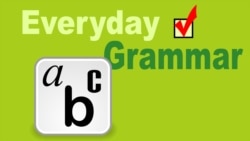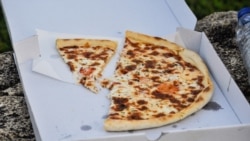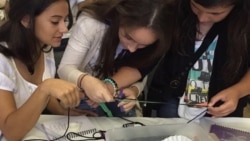This is Everyday Grammar.
Today, I want to begin by asking you to listen to two sentences and compare their meanings. Are the meanings the same or different? Here are the sentences:
Sammy ate the pizza.
It was Sammy who ate the pizza.
So, what did you decide?
This is the answer: The first sentence, “Sammy ate the pizza,” is just a simple statement of fact. The speaker isn’t trying to emphasize – or, call attention to – anything special here.
But in the second sentence, “It was Sammy who ate the pizza,” the speaker is emphasizing that Sammy did the action, not some other person. It is an example of a cleft sentence.
Cleft sentences are one of many ways English speakers use to emphasize part of a sentence. On today’s program, we will talk about the most common type of cleft sentences: the it-cleft.
What is a cleft sentence?
The word “cleft” means partially divided or split. Cleft sentences are “divided” into two parts to emphasize something.
We use a cleft sentence to add new or important information to what the listener already knows. They are especially useful in written form because, in writing, we can’t show stress with our voices.
However, some types of clefts, such as the it-cleft, are also common in speaking.
Think about the example again.
Suppose you were late to a pizza party. Your friend said she would save you two pieces. But by the time you arrived, all the pizza was gone. You think you know who ate your slices.
Listen to a short exchange:
Claudia ate the pizza, didn’t she? She loves pizza.
No. It was Sammy who ate the pizza. He came late, too, and didn’t know I was saving it for you.
In this example, your friend uses a cleft sentence to emphasize that Sammy ate your pizza, not Claudia.
It-clefts
Now that you have a basic understanding, let’s explore it-clefts.
The structure of these sentences tells us exactly what word or words we are supposed to pay attention to. The structure is:
It + BE verb + emphasized information + who/that/when +
known information
Notice that the emphasized information always appears after It + BE verb. Most it-clefts use the past tense of BE and begin with the words “It was.”
Listen to a simple sentence and I’ll show you the possible it-clefts. Here’s the simple sentence:
The girls won the top science prize yesterday.
A few things can be emphasized in this sentence. Here are three possible it-clefts:
It was the girls who won the top science prize yesterday.
Here, the speaker is noting that the girls, not the boys or some other group, won the top prize.
It was yesterday when the girls won the top science prize.
Here, the speaker is noting that their win happened yesterday, not some other day.
It was the top science prize that the girls won yesterday.
And here, the speaker is noting that the girls won the top science prize, not second, third or last prize.
A tale of two clauses
It-cleft sentences are usually made of two clauses. You may remember that a clause is a part of a sentence that has its own subject and verb.
Some clauses can be complete sentences on their own. They are independent clauses. Some cannot be complete sentences. They are dependent clauses.
It-cleft sentences have both an independent clause and a dependent clause. It + BE verb is the independent clause. The rest of the sentence is a dependent clause.
Sound complex? Not to worry! You can learn more about clauses in other Everyday Grammar programs.
The goal today is knowing how to make it-cleft sentences and knowing they have two parts -- the first part with new information; the second with known or old information.
For instance, in the sentence “It was the girls who won the top science prize yesterday,” the first part, “It was the girls,” has new information. The second part, “…won the top science prize yesterday,” is information already known to the listener.
More about it-clefts
Wow, I’ve said a mouthful already! But I want to briefly tell you one more thing: Cleft sentences often take other forms in everyday speech and writing.
For example, they can take a question form, like this:
Was it the girls who won the top science prize yesterday?
They can also take a negative form, like this:
It wasn’t the girls who won the top science prize yesterday.
That’s all for now. Watch for other programs on cleft sentences in the coming weeks.
I’m Alice Bryant.
Alice Bryant wrote this story for Everyday Grammar. Kelly Jean Kelly was the editor.
_________________________________________________________________
Words in This Story
emphasize - n. to give special importance or attention given to something (synonym of stress)
type - n. a particular kind or group of things or people
stress - n. special importance or attention that is given to something (synonym of emphasis)












